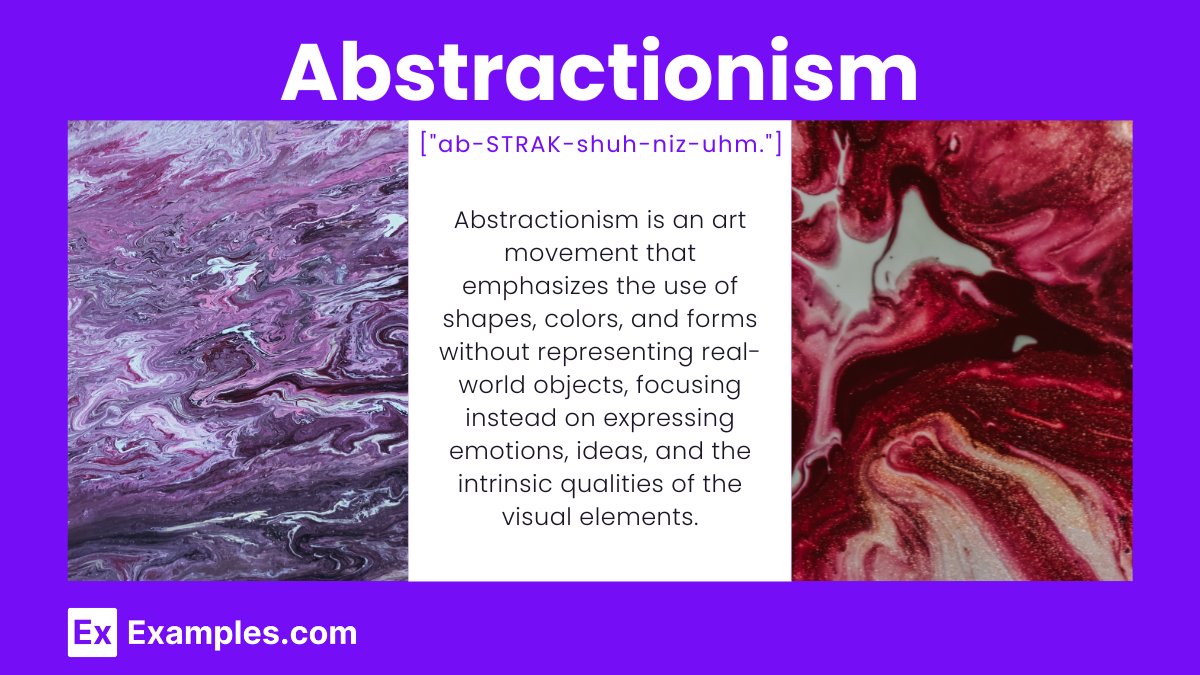15+ Abstractionism Examples
Abstracion has evolved from its late 19th-century roots to the present day. Very adaptable, abstract art may be subdivided into many subgenres without losing its identity as a universal artistic movement. This ranges from Abstract Expressionism and Minimalism through Lyrical Abstraction and Color Field painting and Post-Painterly Abstraction.
What is Abstractionism?
The term Abstractionism may be used to describe works of art that are based on a person, objective, or landscape but in which the shapes have been reduced or schematized. It is also used to describe works of art that make use of forms, such as geometric shapes or gestural markings, that are not based on any external visual reality in any way. In history and politics, abstractionism was used to describe movements like communism and socialism to influence society. In today’s modernity, these types of art can be found even on advertisements as a revolutionary way to attract consumers.
Types of Abstractionism
1. Geometric Abstraction: Focuses on the use of geometric shapes like squares, circles, and triangles. Artists often employ mathematical principles to create balanced and harmonious compositions.
- Example: Piet Mondrian’s “Composition with Red, Blue, and Yellow.”
2. Lyrical Abstraction: Emphasizes personal expression and emotional content. This type of abstraction often features spontaneous and free-form shapes, with a focus on color and movement.
- Example: Wassily Kandinsky’s “Composition VIII.”
3. Abstract Expressionism: Centers on spontaneous, automatic, or subconscious creation. This type often features dynamic and gestural brushstrokes, emphasizing the artist’s emotional state.
- Example: Jackson Pollock’s drip paintings.
4. Minimalism: Strips down the elements to their most basic forms, focusing on simplicity and purity. Minimalist works often use limited colors and simple shapes to create a powerful impact.
- Example: Ellsworth Kelly’s “Blue Green Red.”
5. Color Field Painting: Involves large areas of a single color or simple color gradients. The focus is on the interaction of colors to evoke emotional responses.
- Example: Mark Rothko’s color field paintings.
6. Suprematism: Founded by Kazimir Malevich, Suprematism emphasizes basic geometric shapes and limited color palettes to convey pure artistic feeling.
- Example: Kazimir Malevich’s “Black Square.”
7. Cubism: Developed by Pablo Picasso and Georges Braque, Cubism breaks objects into geometric shapes and reassembles them in abstract forms, presenting multiple perspectives simultaneously.
- Example: Pablo Picasso’s “Les Demoiselles d’Avignon.”
8. Futurism: Originating in Italy, Futurism emphasizes movement, speed, and technology. It often features dynamic compositions with a sense of motion and energy.
- Example: Umberto Boccioni’s “Unique Forms of Continuity in Space.”
9. Orphism: A branch of Cubism that focuses on pure abstraction and bright colors, aiming to evoke musical qualities and the harmony of color.
- Example: Robert Delaunay’s “Simultaneous Windows on the City.”
10. De Stijl: Also known as Neoplasticism, this Dutch movement uses vertical and horizontal lines and primary colors to create a sense of order and harmony.
- Example: Piet Mondrian’s “Broadway Boogie Woogie.”
Examples of Abstractionism
1. Wassily Kandinsky’s “Composition VIII” (1923)
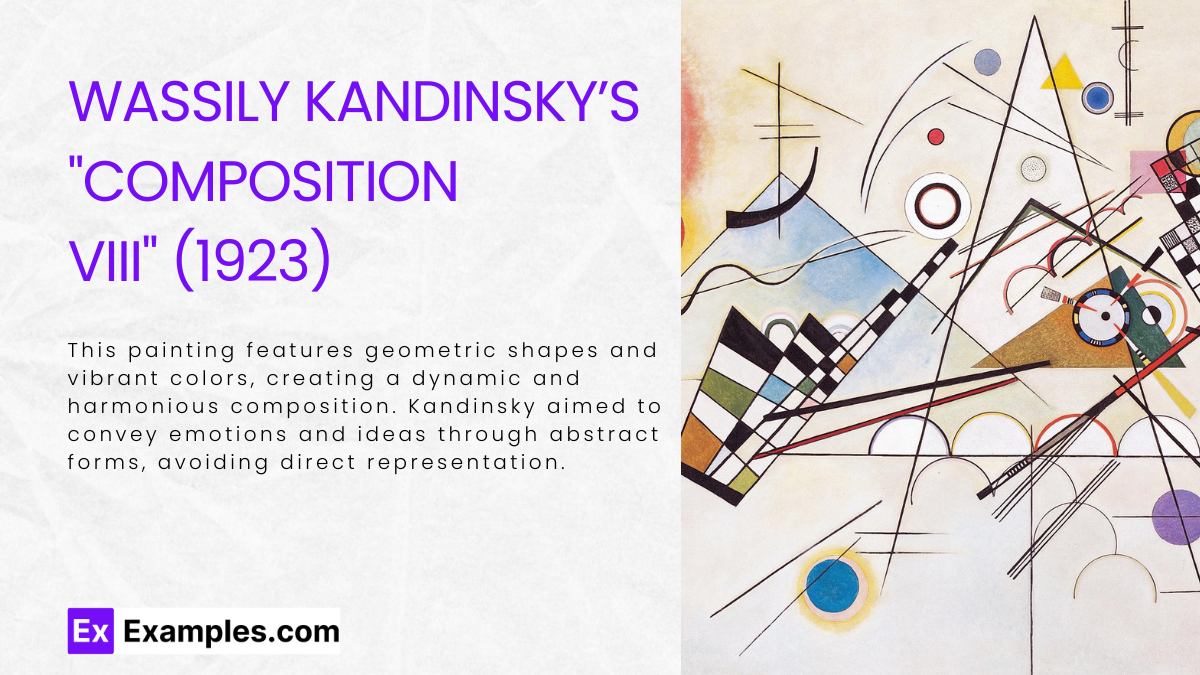
This painting features geometric shapes and vibrant colors, creating a dynamic and harmonious composition. Kandinsky aimed to convey emotions and ideas through abstract forms, avoiding direct representation.
2. Piet Mondrian’s “Composition with Red, Blue, and Yellow” (1930)
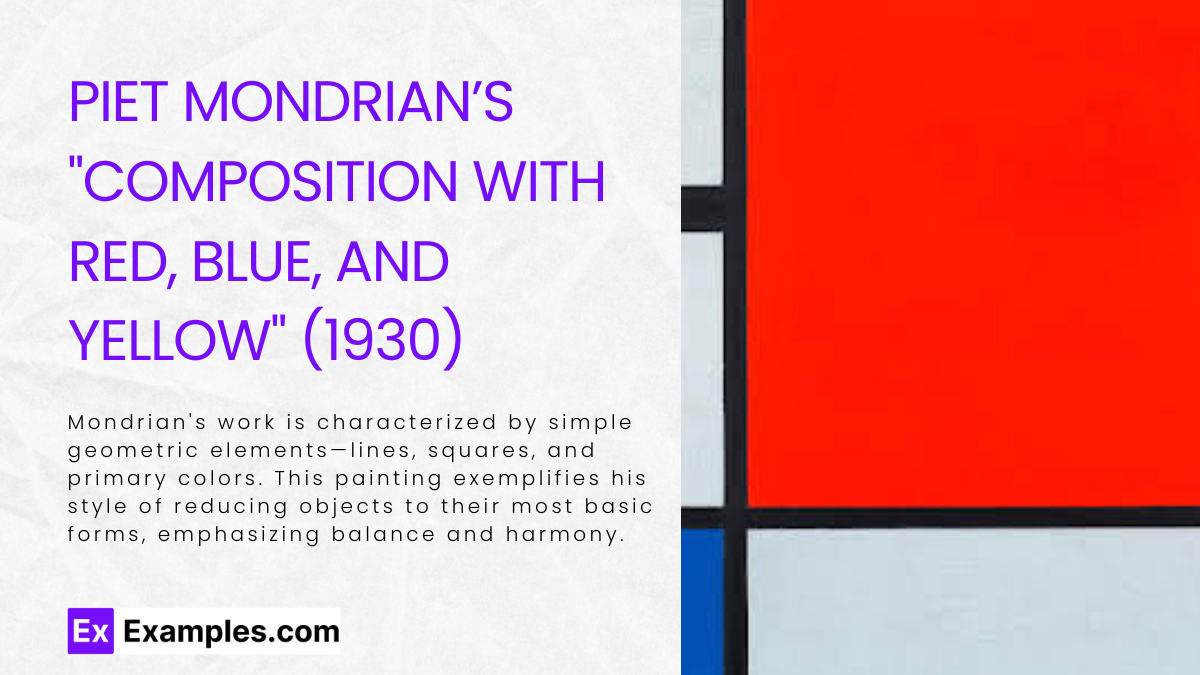
Mondrian’s work is characterized by simple geometric elements—lines, squares, and primary colors. This painting exemplifies his style of reducing objects to their most basic forms, emphasizing balance and harmony.
3. Kazimir Malevich’s “Black Square” (1915)
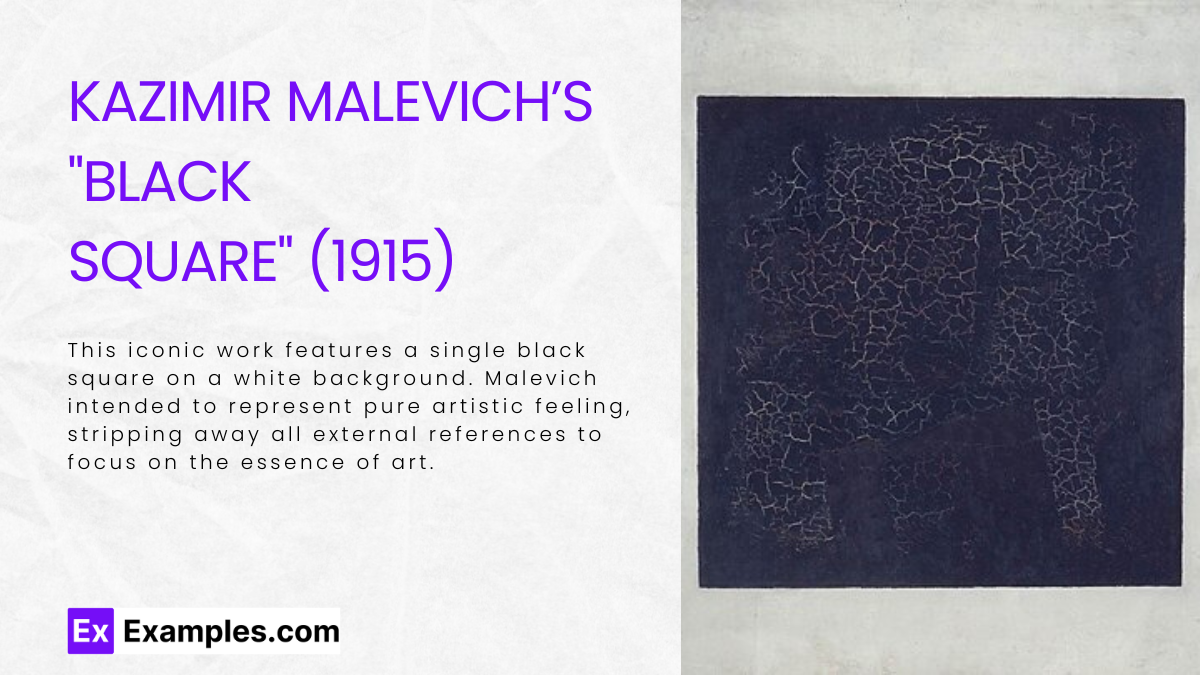
This iconic work features a single black square on a white background. Malevich intended to represent pure artistic feeling, stripping away all external references to focus on the essence of art.
4. Jackson Pollock’s “No. 5, 1948”
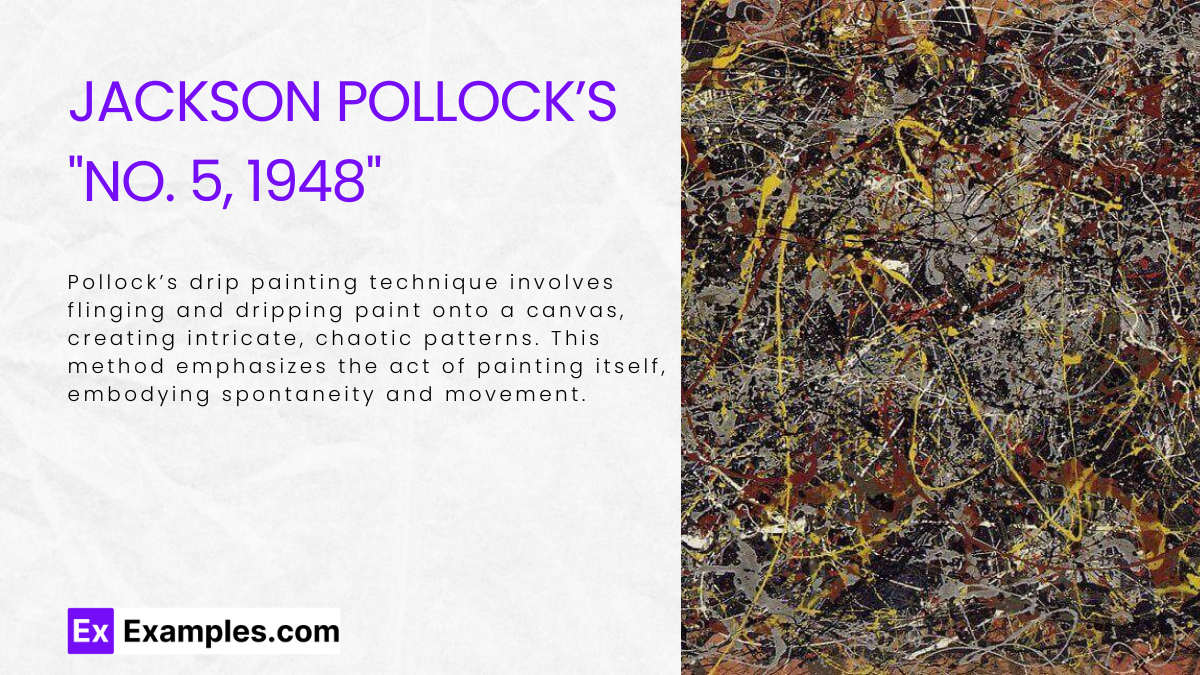
Pollock’s drip painting technique involves flinging and dripping paint onto a canvas, creating intricate, chaotic patterns. This method emphasizes the act of painting itself, embodying spontaneity and movement.
5. Mark Rothko’s “No. 61 (Rust and Blue)” (1953)
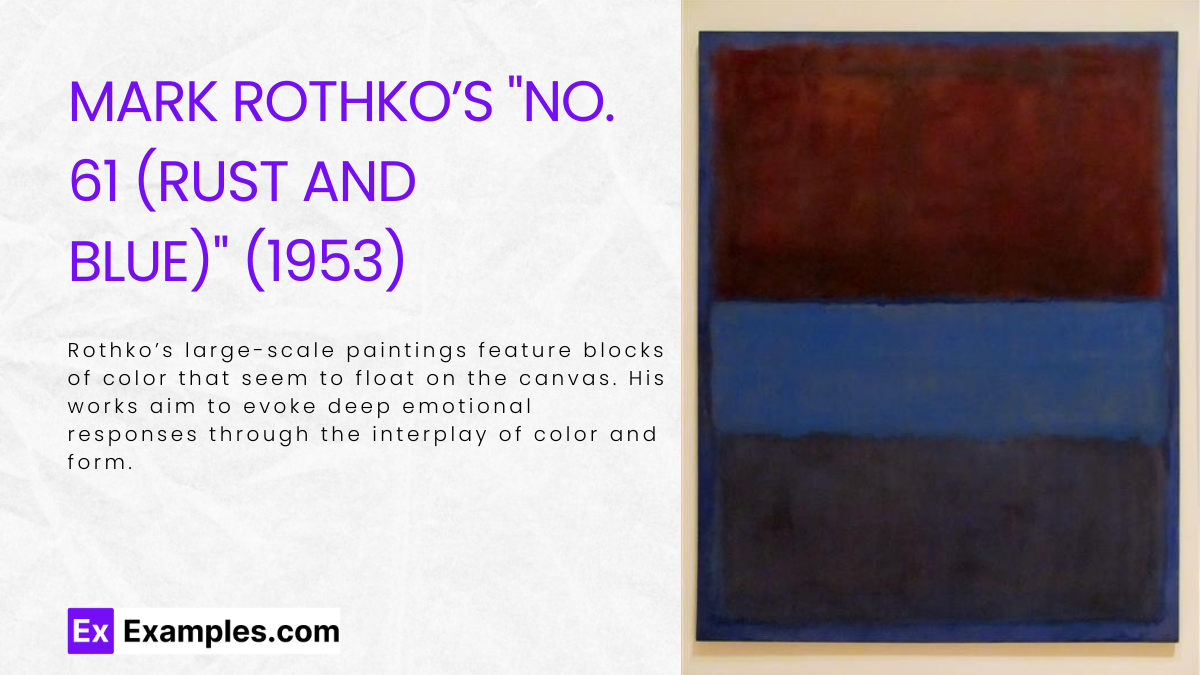
Rothko’s large-scale paintings feature blocks of color that seem to float on the canvas. His works aim to evoke deep emotional responses through the interplay of color and form.
6. Joan Miró’s “The Harlequin’s Carnival” (1924)
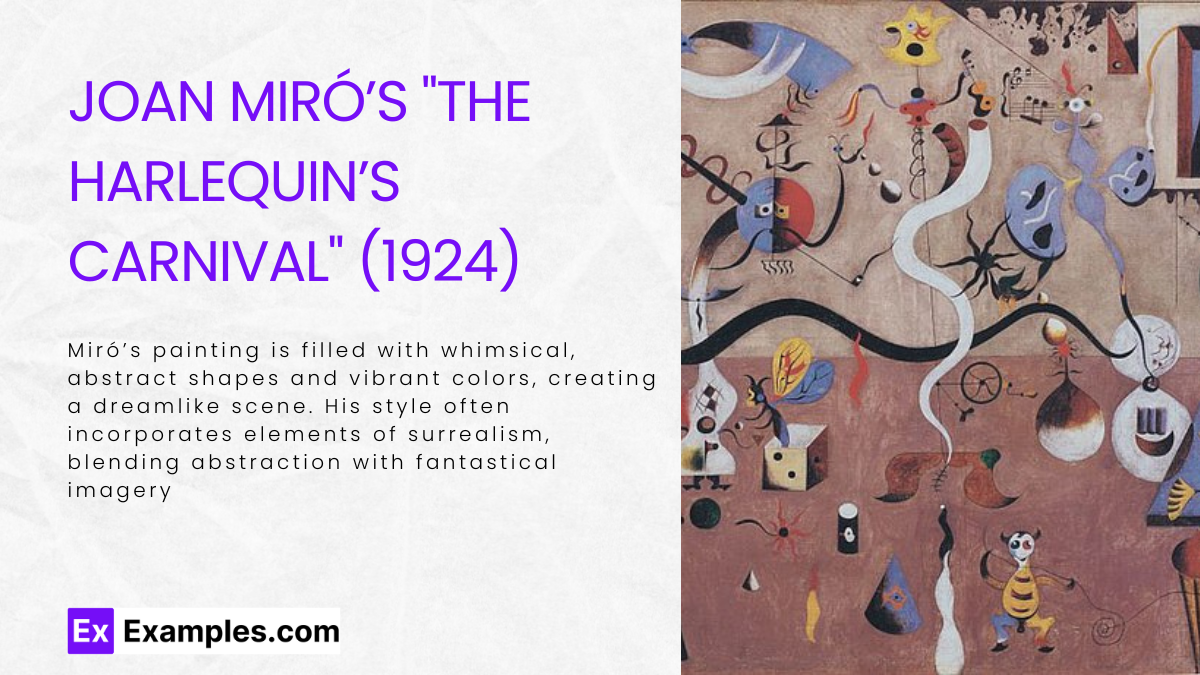
Miró’s painting is filled with whimsical, abstract shapes and vibrant colors, creating a dreamlike scene. His style often incorporates elements of surrealism, blending abstraction with fantastical imagery.
7. Robert Delaunay’s “Simultaneous Windows on the City” (1912)

This painting features fragmented, colorful shapes that depict a cityscape from multiple perspectives. Delaunay’s work explores the relationship between color and form, and how they can convey movement and energy.
8. Paul Klee’s “Senecio” (1922)

Klee’s work combines geometric shapes and bold colors to create an abstract portrait. His style often includes whimsical and playful elements, blending abstraction with a hint of figuration.
9. Helen Frankenthaler’s “Mountains and Sea” (1952)
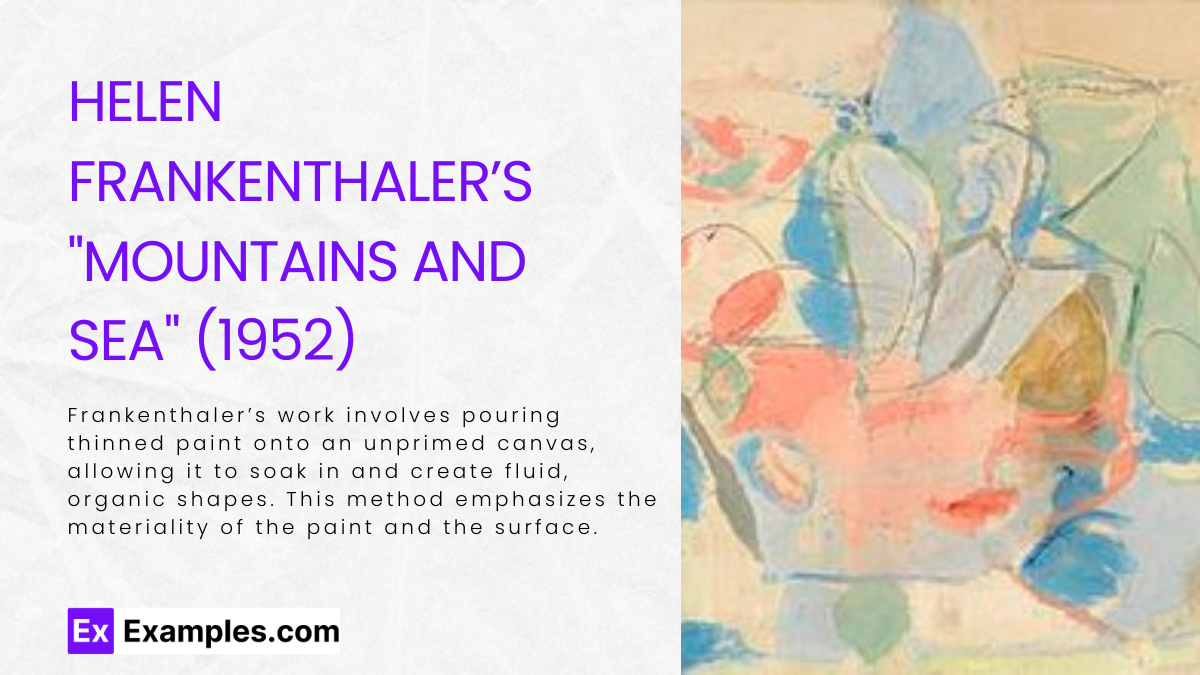
Frankenthaler’s work involves pouring thinned paint onto an unprimed canvas, allowing it to soak in and create fluid, organic shapes. This method emphasizes the materiality of the paint and the surface.
10. Ellsworth Kelly’s “Blue Green Red” (1963)
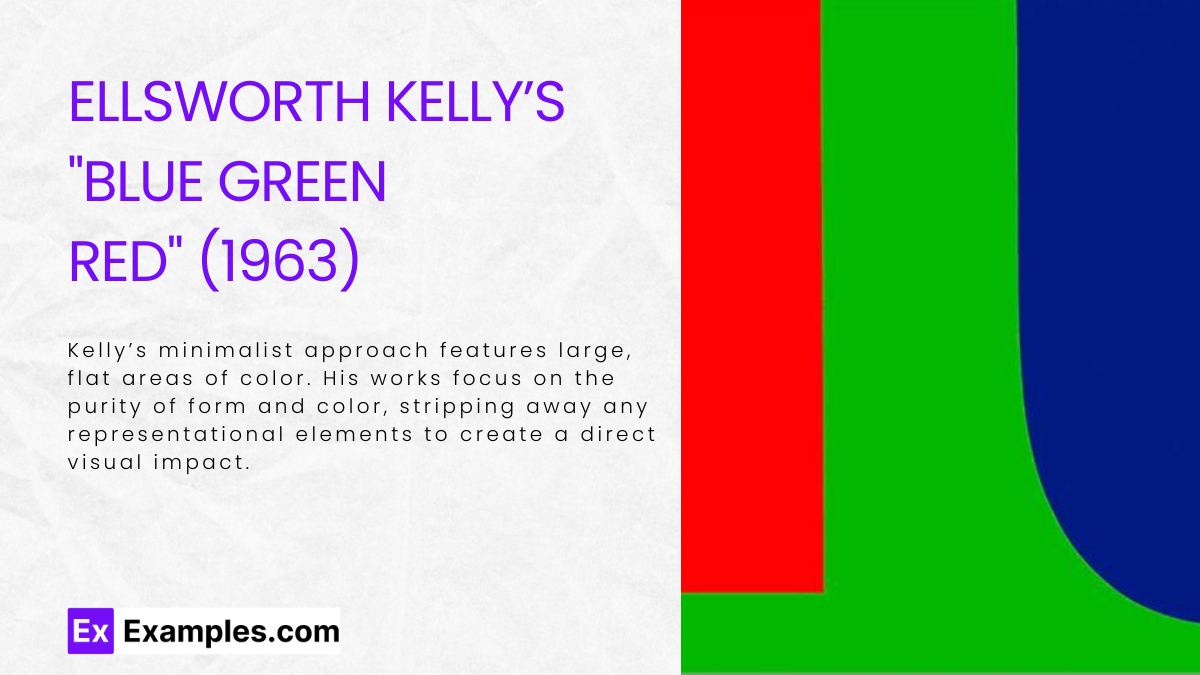
Kelly’s minimalist approach features large, flat areas of color. His works focus on the purity of form and color, stripping away any representational elements to create a direct visual impact.
Abstractionism Examples & Samples in PDF:
1. Essence of Form Abstraction
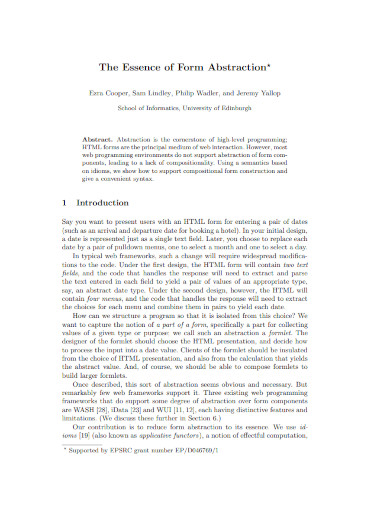
homepages.inf.ed.ac.uk
2. Generic Model Abstraction Examples
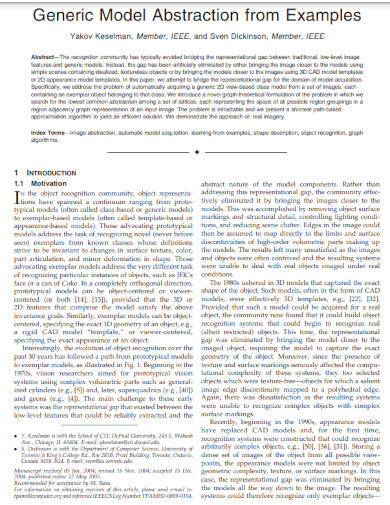
cs.toronto.edu
3. Using Abstraction for Generalized Planning
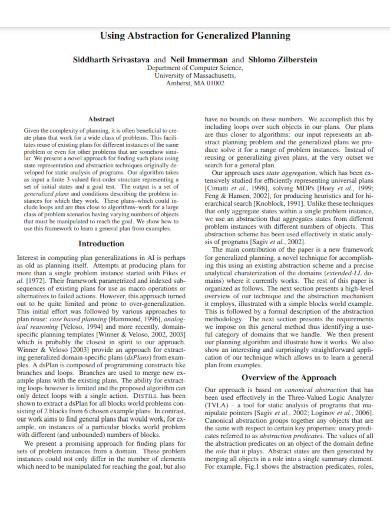
people.cs.umass.edu
4. Notice of Emergency Abstraction
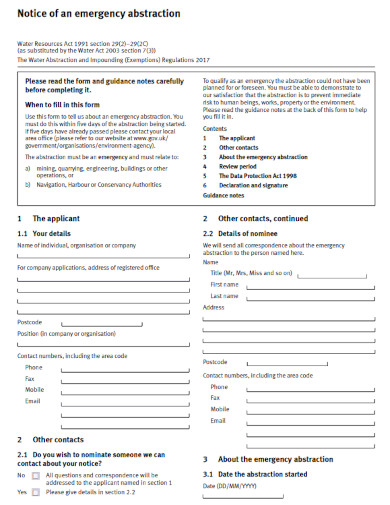
assets.publishing.service.gov.uk
5. Chart Abstraction Template

chcf.org
Purpose of Abstractionism
1. Expression of Emotions and Ideas: Abstractionism allows artists to convey complex emotions, thoughts, and concepts without the constraints of realistic representation. The use of color, form, and composition can evoke feelings and moods that words cannot capture.
2. Exploration of Pure Form and Color: Abstract artists focus on the fundamental elements of art, such as shape, line, color, and texture. This emphasis on pure form and color helps to explore the intrinsic properties of these elements, often leading to a more profound appreciation of their aesthetic qualities.
3. Breaking Away from Tradition: Abstractionism emerged as a reaction against traditional, realistic art forms. It represents a shift towards innovation and experimentation, challenging conventional boundaries and encouraging new ways of seeing and thinking about art.
4. Personal and Subjective Interpretation: Abstract art invites viewers to interpret the work in their own way, allowing for a diverse range of personal responses. This subjective experience is central to abstractionism, as it engages the audience in a more intimate and individual way.
5. Focus on the Creative Process: Many abstract artists emphasize the act of creation itself. The techniques and methods used, such as dripping, pouring, or layering paint, are as important as the final work. This focus on process highlights the physicality and spontaneity of art-making.
6. Representation of the Non-Visible: Abstractionism often seeks to represent ideas or realities that are not visible or tangible, such as spiritual beliefs, inner experiences, or universal truths. By moving away from concrete imagery, abstract art can delve into metaphysical or philosophical themes.
7. Encouraging Innovation and Experimentation: Abstract art fosters an environment of creativity and exploration. Artists experiment with new materials, techniques, and concepts, pushing the boundaries of what art can be and do.
8. Universality and Timelessness: Abstract forms can transcend cultural and temporal boundaries. By focusing on universal elements like color and shape, abstract art can resonate with a wide range of audiences, regardless of their background or the time period.
Characteristics of Abstractionism
1. Non-Representational Forms: Abstractionism avoids direct representation of objects, people, or scenes. Instead, it focuses on shapes, colors, and forms that do not depict real-world entities.
2. Emphasis on Geometric and Organic Shapes: Artists use geometric shapes like circles, squares, and triangles or organic, free-flowing forms. These shapes can be arranged in complex compositions to convey various themes and emotions.
3. Bold Use of Color: Vibrant and contrasting colors are often used to create visual impact and convey emotions. Color choice is crucial in abstract art as it can set the mood and tone of the piece.
4. Focus on Line and Form: Lines, whether straight, curved, or jagged, play a significant role in structuring the composition. The interaction between lines and forms creates movement and guides the viewer’s eye through the artwork.
5. Simplification and Reduction: Abstractionism involves reducing subjects to their most basic elements. This simplification helps to focus on the essence of the subject, stripping away unnecessary details.
6. Textural Variety: Abstract artists often experiment with different textures to add depth and interest. This can include the use of different materials, techniques, and layering of paint.
7. Emotional and Expressive: Abstract art aims to evoke emotions and convey the artist’s inner feelings and thoughts. The absence of recognizable subjects allows viewers to connect with the work on a more intuitive and emotional level.
8. Dynamic Compositions: Many abstract works feature dynamic, energetic compositions that convey movement and change. This can be achieved through the use of flowing lines, overlapping shapes, and varied textures.
9. Innovative Techniques: Abstractionism encourages experimentation with new techniques and materials. Artists might use unconventional methods like dripping, splattering, or scraping paint to achieve unique effects.
10. Ambiguity and Open Interpretation: Abstract art is often open to multiple interpretations. The lack of clear subjects allows viewers to project their own meanings and emotions onto the artwork, making each viewing experience unique.
Abstractionism Philosophy
1. Emphasis on Artistic Autonomy:
- Abstractionism champions the idea that art does not need to depict real-world objects or scenes to be meaningful. It promotes the notion that the intrinsic qualities of the artwork—such as color, form, line, and texture—can convey profound messages and evoke emotions independently of representational content.
2. Focus on Universal Elements:
- Abstract art aims to transcend cultural, historical, and social contexts by focusing on universal elements that are understandable regardless of background. By stripping away specific references, abstractionism seeks to communicate on a more fundamental, universally human level.
3. Expression of the Sublime:
- Many abstract artists aim to express the sublime, a concept often associated with awe, beauty, and grandeur. Through non-representational forms, artists attempt to evoke a sense of the infinite, the spiritual, or the deeply emotional, going beyond the limitations of the physical world.
4. Exploration of Inner Reality:
- Abstractionism is deeply connected to the exploration of the artist’s inner world, emotions, and subconscious mind. It often draws from the belief that the true essence of reality is internal rather than external, and that art should reflect the internal experiences of the artist.
5. Innovation and Experimentation:
- The philosophy of abstractionism encourages constant innovation and experimentation. By moving away from traditional methods and subjects, artists are free to explore new techniques, materials, and ideas, pushing the boundaries of what art can be.
6. Rejection of Traditional Aesthetics:
- Abstract art often rejects the conventional aesthetics of beauty and harmony associated with realistic art. Instead, it embraces a broader range of visual languages and expressions, sometimes challenging viewers’ perceptions and expectations.
7. Emphasis on Viewer Interpretation:
- Abstractionism places significant importance on the viewer’s role in interpreting the artwork. The lack of clear, representational content invites viewers to engage with the art on a personal level, finding their own meanings and emotional responses.
8. Focus on the Process:
- Many abstract artists value the creative process as much as, or even more than, the final product. The act of painting, with its gestures, rhythms, and physical engagement, is seen as an essential part of the artwork’s meaning.
9. Spiritual and Mystical Pursuits:
- For some abstract artists, the movement represents a way to explore spiritual and mystical dimensions. Artists like Wassily Kandinsky believed that abstract art could communicate spiritual truths and connect with the viewer’s soul.
10. Reaction Against Realism:
- Abstractionism often arose as a reaction against the constraints and perceived limitations of realistic art. By rejecting realism, abstract artists sought to explore new ways of seeing and understanding the world, beyond the visible and tangible.
Abstractionism Psychology
1. Expression of Subconscious Thoughts:
- Abstractionism allows artists to express subconscious thoughts and emotions, bypassing rational thought processes. Techniques like automatic drawing and spontaneous creation are often used to tap into the unconscious mind, bringing hidden feelings and ideas to the surface.
2. Emotional Resonance:
- Abstract art is designed to evoke emotional responses from viewers. The use of color, shape, and form can provoke feelings of joy, sadness, tension, or calmness, depending on the viewer’s personal experiences and psychological state.
3. Viewer Interpretation and Perception:
- Abstract art is highly subjective, encouraging viewers to project their own thoughts, emotions, and experiences onto the artwork. This open-ended nature of abstractionism means that each viewer can derive a unique meaning and emotional response based on their psychological makeup.
4. Cognitive Engagement:
- Engaging with abstract art often requires viewers to use higher-order cognitive processes such as interpretation, analysis, and synthesis. This active engagement can stimulate mental processes, encouraging viewers to think creatively and explore new perspectives.
5. Visual Perception and Gestalt Psychology:
- Abstract art often plays with visual perception, exploring how we organize and interpret visual information. Gestalt psychology, which studies how people perceive visual components as unified wholes, is particularly relevant. Abstract art can challenge the brain’s tendency to seek patterns and complete unfinished forms.
6. Reduction of Stress and Anxiety:
- Creating and viewing abstract art can have therapeutic benefits, helping to reduce stress and anxiety. The freedom and lack of rules in abstract art can provide a sense of release and relaxation, both for artists and viewers.
7. Personal Expression and Identity:
- For artists, abstractionism offers a means of personal expression that is not bound by realistic representation. It allows artists to explore and express their identities, inner thoughts, and emotional states in a way that is unique and deeply personal.
8. Enhancing Creativity:
- Abstract art encourages both artists and viewers to think outside the box and explore new ideas. This emphasis on creativity and innovation can enhance problem-solving skills and foster a more open and flexible mindset.
9. Impact of Color Psychology:
- Colors play a significant role in abstract art, each color can evoke specific psychological responses. For example, blue can create a sense of calm and stability, while red might evoke passion or intensity. Abstract artists often use color theory to influence viewers’ emotional and psychological reactions.
10. Nonverbal Communication:
- Abstract art can communicate complex emotions and ideas without the need for words. This form of nonverbal communication can be powerful, allowing for a more immediate and visceral connection between the artwork and the viewer.
How to do Abstractionism
Since it asks you to conceive about concepts in ways that don’t reflect the objective world and to perceive in novel ways, Abstractionism challenges your imagination and helps you grow. The best approach to train your imagination is to release it from the constraints of reality.
Step 1: Focus within rather than outward
Remembering that there is no such thing as “bad” in abstract art is the single most crucial thing to keep in mind while creating such works. Instead of looking around you for inspiration, try reflecting on your inner experiences and seeing what you can draw. This is also a common practise in symbolism (see examples of symbolism in poetry and short story)
Step 2: Pay homage to the greats
Do this exercise: dissect a masterpiece into its component parts, paying little attention to the finer aspects. Attempt a new layout by redoing the shapes (either by hand or using paper templates) and then redrawing them.
Step 3: Do it first in black and white
The most revolutionary action you can do is to just let your guard down and play. If you’re just starting out with abstract art, you may find it helpful to focus on forms and composition first, before going on to color (read examples of color chart here).
Step 4: Focus on space
The organization of space is the primary concern for the abstract artist. Think of everything as contributing to the whole as much as possible.
Step 5: Make it big
Artists who don’t believe in themselves often create insignificant works. Don’t be scared to dive in with some larger designs so you can get some perspective as you go.
Step 6: Doodle
The painting process itself is significant, since each choice has consequences for the final product. Doodling is a great way to see where your ideas could go, whether you’re working with paper or clay, whether you’re entirely open-minded or if you already have a hazy notion in mind.
What is Abstractionism?
Abstractionism is an art movement focusing on shapes, colors, and forms that do not represent real-world objects, emphasizing emotional and conceptual expression over realistic depiction.
Who are key figures in Abstractionism?
Key figures include Wassily Kandinsky, Piet Mondrian, Kazimir Malevich, Jackson Pollock, and Mark Rothko, who pioneered various approaches to abstract art.
What are the main characteristics of Abstractionism?
Characteristics include non-representational forms, bold colors, geometric and organic shapes, emotional expression, simplification, and a focus on line, form, and texture.
How does Abstractionism differ from realism?
Unlike realism, which depicts subjects as they appear in real life, Abstractionism uses shapes, colors, and forms to convey emotions and ideas without direct representation.
Why is color important in Abstractionism?
Color is used to evoke emotions, set moods, and create visual impact, often serving as the primary means of expression in abstract art.
How does abstractionism engage the viewer?
It invites personal interpretation, encouraging viewers to project their own thoughts and feelings onto the artwork, resulting in unique and varied emotional responses.
What techniques are used in Abstractionism?
Techniques include dripping, pouring, and layering paint, as well as experimenting with different textures, materials, and spontaneous creation methods.
How does abstractionism relate to psychology?
It explores subconscious thoughts and emotions, engages cognitive processes, and can reduce stress and anxiety, providing therapeutic benefits for both artists and viewers.
What is the purpose of abstractionism?
The purpose is to express emotions, explore pure form and color, break from tradition, encourage innovation, and allow for personal and subjective interpretation.
How has abstractionism influenced modern art?
It has expanded artistic expression, fostering innovation and experimentation in techniques, materials, and concepts, significantly shaping contemporary art practices.



